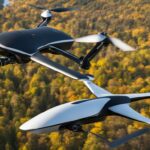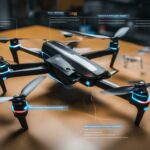Unmanned aircraft, also known as drones, have gained significant popularity and are transforming various industries. The drone market has experienced rapid growth and continues to evolve with emerging technologies. From military applications to commercial usage, drones are revolutionizing the way businesses operate. This article explores the latest trends in drone technology and how they are shaping the future of aviation.
Key Takeaways: Drone Technology Trends
- Drone technology is rapidly advancing and reshaping the aviation industry
- The drone market is experiencing significant growth with emerging technologies
- Various industries, including military and commercial sectors, are adopting drone technology
- The integration of artificial intelligence and autonomous capabilities is revolutionizing drone applications
- The future of drone technology holds immense potential for innovation and industry disruption
The Current State of the Drone Market
The drone market is experiencing significant advancements and growth, with new technologies constantly emerging. The industry is witnessing a surge in drone advancements, driving the growth of the drone technology sector. This growth is fueled by the increasing adoption of drones across various industries, including military, commercial, and personal use.
The military sector has been a major driver of drone technology, utilizing unmanned aerial vehicles for combat missions, target decoys, and research and development. The commercial sector is also embracing drone technology, utilizing it for delivery services, surveillance, aerial photography, and more. Personal drones are gaining popularity among enthusiasts for recreational purposes.
The drone industry’s continuous development is fueled by ongoing investments in drone technology research and development. Drone tech news showcases the latest innovations and breakthroughs in drone hardware, software, and design. Companies and researchers are constantly pushing the boundaries of what drones can accomplish, leading to exciting advancements in the field.
To gain a deeper understanding of the current state of the drone market, let’s take a look at the below table summarizing key drone industry growth statistics:
| Industry Sector | Growth Rate | Key Developments |
|---|---|---|
| Military | High | Increased adoption for combat missions and target decoys |
| Commercial | Significant | Rapid growth in delivery services and surveillance applications |
| Personal | Steady | Growing popularity among hobbyists and recreational users |
As the drone industry continues to evolve, it is essential to stay updated with the latest drone advancements, industry growth trends, and drone technology development. This will enable businesses and individuals to leverage the full potential of drones and make informed decisions in this exciting and dynamic field.
Drone Technology Today and Its Uses
Drone technology has undergone significant advancements in recent years, resulting in improved software, hardware, and design. These advancements have paved the way for a wide range of applications across various industries. Whether it’s aerial photography, disaster management, precision agriculture, or law enforcement surveillance, drones are being utilized in innovative ways to enhance operations and collect valuable data.
One key aspect of drone technology is the development of specialized software that enables drones to perform complex tasks with precision. Drone software allows for autonomous flight, intelligent navigation, and the execution of specific missions. It also facilitates real-time data capture and analysis, enabling industries to make informed decisions based on accurate and up-to-date information.
Alongside software advancements, drone hardware has also seen significant improvements. Drones are now equipped with advanced sensors, cameras, and other technological components that enhance their performance and data collection capabilities. These hardware enhancements ensure high-quality image capture, accurate GPS tracking, obstacle avoidance, and longer flight times.
“Drone technology has become an indispensable tool in various industries, revolutionizing the way tasks are performed and data is collected.” – Industry Expert
Drone Design and Operational Trends
In addition to software and hardware advancements, drone design has also evolved to meet specific industry needs. Compact and foldable designs have made drones more portable, allowing for easy transportation and deployment in various environments. Additionally, waterproof and ruggedized drones have been developed for applications in extreme weather conditions or challenging terrains.
Operational trends in the drone industry are influenced by the increasing demand for automated capabilities and improved flight performance. Beyond visual line of sight (BVLOS) operations, improved battery life, and enhanced obstacle detection and avoidance systems are some of the key areas of focus. These trends aim to make drones more efficient, reliable, and safe for commercial and industrial use.
| Drone Applications | Benefits |
|---|---|
| Aerial Photography | High-quality image and video capture from unique vantage points |
| Disaster Management | Rapid assessment of affected areas and delivery of essential supplies |
| Precision Agriculture | Optimized crop management, reduced resource wastage, and increased yields |
| Law Enforcement Surveillance | Enhanced situational awareness, crime prevention, and public safety |
| Building Inspections | Safe and efficient inspection of structures, reducing risks and costs |
Drones have become integral to various industries, offering immense potential for increased efficiency, cost savings, and data-driven decision making. As drone technology continues to evolve, we can expect even more innovative applications and advancements that will further shape the future of industries worldwide.
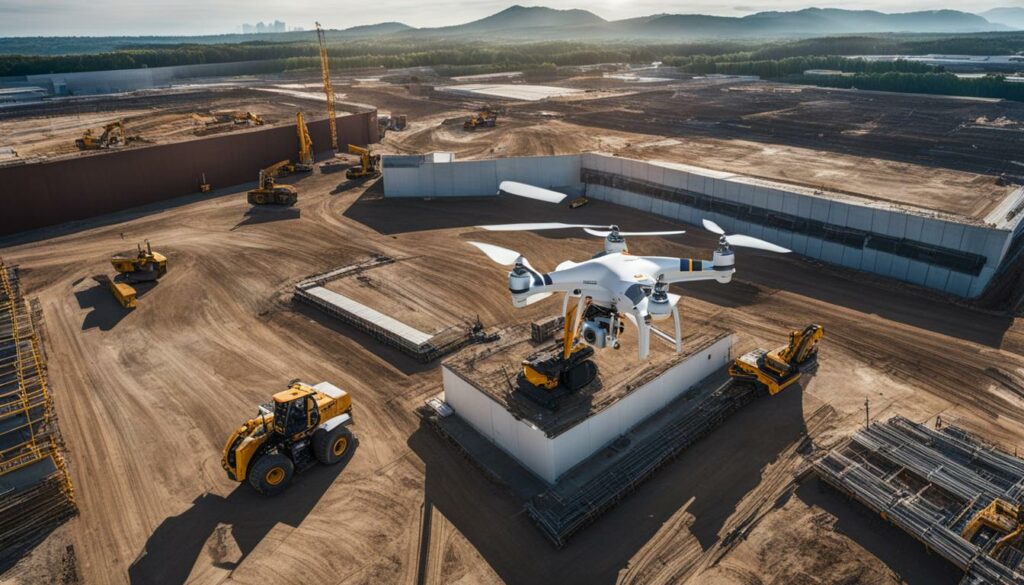
The Impact of Drone Technology in the Military
The military sector has greatly benefited from the advancements in drone technology, enabling them to carry out their operations more effectively and efficiently. Drones have revolutionized warfare by providing a range of capabilities that were previously unimaginable. Let’s take a closer look at how drone technology is transforming the military.
Enhancing Surveillance and Reconnaissance
One of the key applications of drone technology in the military is surveillance and reconnaissance. Drones equipped with high-resolution cameras and advanced sensors can provide real-time aerial intelligence, enabling military personnel to gather vital information about enemy positions, terrain, and potential threats without putting human lives at risk. This allows for better strategic planning and decision-making on the battlefield.
Moreover, the use of drones for surveillance purposes can aid in counter-terrorism operations, border security, and monitoring of critical infrastructure. Drones provide a cost-effective and efficient solution for continuous surveillance, covering large areas without the need for extensive manpower.
Supporting Combat Missions
Drone technology has also significantly contributed to combat missions. Armed drones, commonly known as unmanned combat aerial vehicles (UCAVs), have the ability to carry out precision strikes on enemy targets with high accuracy. These drones are equipped with guided missiles, rockets, and other munitions, enabling the military to neutralize threats while minimizing collateral damage.
The use of UCAVs has proven to be particularly effective in counter-terrorism operations, as they provide the military with the ability to conduct targeted strikes against high-value targets without risking the lives of ground troops. This has changed the dynamics of modern warfare and has allowed the military to carry out missions with reduced risks and increased efficiency.
| Advantages of Drone Technology in the Military | Challenges in the Implementation |
|---|---|
|
|
“The use of drone technology in the military has revolutionized warfare, providing enhanced surveillance capabilities, precision strikes, and reduced risks for military personnel.”
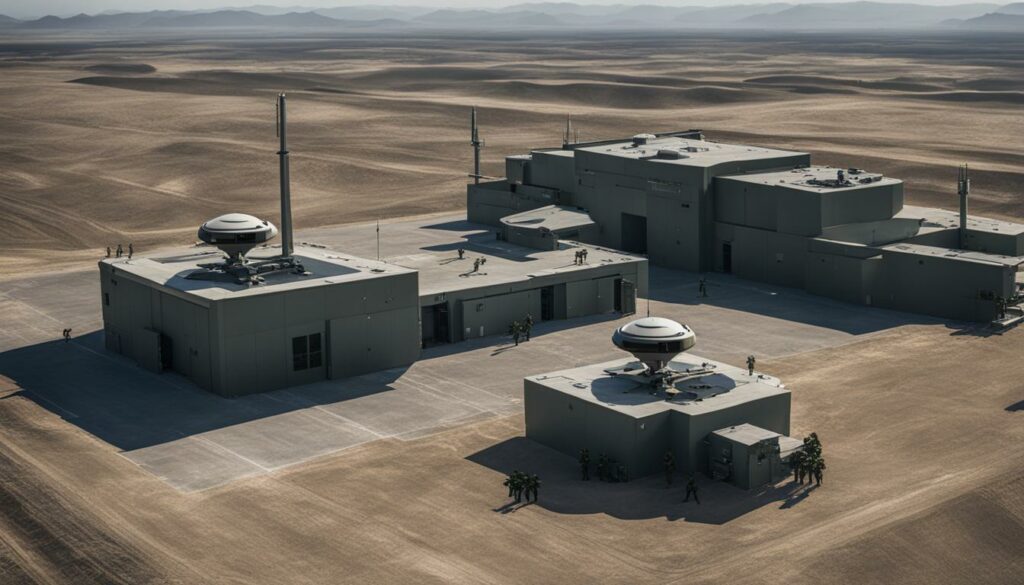
While drone technology has undoubtedly provided numerous advantages to the military, there are also challenges that need to be addressed. Vulnerability to cyber attacks, regulatory and legal concerns, integration with existing systems, and training and skills development are among the key challenges that military organizations face in implementing drone technology.
Despite these challenges, the impact of drone technology in the military cannot be underestimated. As technology continues to evolve, drones are expected to play an even greater role in future military operations, contributing to enhanced national security and promoting the safety of military personnel.
Commercial Applications of Drone Technology
As drone technology continues to advance, it is revolutionizing the commercial sector with its wide range of applications. From delivery services to aerial photography, drones are becoming an integral part of many industries. Let’s explore some of the current trends in commercial drone usage.
Drone Delivery Trends
The concept of drone delivery has gained traction in recent years, with companies like Amazon and UPS testing its feasibility. Drones offer a faster and more efficient way to deliver goods, especially in areas with challenging terrains or congested roads. With advancements in technology and regulations, we can expect to see an increase in drone delivery services in the near future.
Drone Surveillance Technology
Drone surveillance technology has proven to be a game-changer in the security industry. Drones equipped with high-resolution cameras and thermal sensors can monitor large areas from above, providing real-time video feeds and data collection. This capability is particularly useful for surveillance in remote or inaccessible locations, such as border control or industrial sites. Drone surveillance technology offers enhanced safety and efficiency compared to traditional security methods.
Drone Photography Trends
The use of drones in aerial photography has opened up new creative possibilities for photographers and filmmakers. Drones equipped with high-quality cameras and stabilization systems can capture stunning images and videos from unique perspectives. Whether it’s capturing landscapes, events, or real estate, drone photography is becoming increasingly popular. It allows for the creation of visually engaging content that stands out from traditional ground-based photography.
| Commercial Drone Trends | Drone Delivery Trends | Drone Surveillance Technology | Drone Photography Trends |
|---|---|---|---|
| Increasing adoption across industries | Faster and more efficient delivery | Real-time monitoring and data collection | Capturing unique perspectives |
| Growth in the drone services market | Overcoming challenging terrains and congestion | Enhanced safety and efficiency | Creative possibilities for photographers |
| Boosting the economy and creating job opportunities | Advancements in technology and regulations | Increased scalability and accessibility | Visually engaging content |
In conclusion, commercial drone technology is experiencing significant growth and transforming various industries. From delivery services to surveillance and photography, drones offer innovative and efficient solutions. As technology continues to advance, we can expect to see further integration of drones in commercial operations, bringing exciting opportunities and advancements to the market.
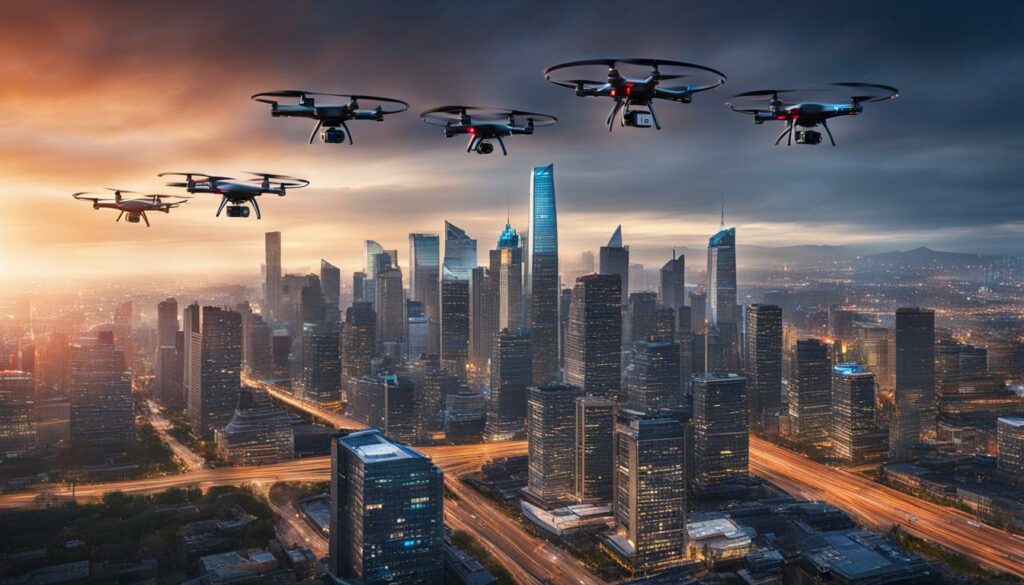
The Potential of Autonomous Drone Delivery
Autonomous drone delivery is revolutionizing the way goods are transported and delivered, offering numerous advantages over traditional delivery methods. These advanced drones are equipped with state-of-the-art technology, including obstacle avoidance systems, GPS tracking, and precise navigation capabilities. With their ability to fly autonomously and efficiently, autonomous drones are transforming industries such as e-commerce, healthcare, and logistics.
One of the key benefits of autonomous drone delivery is the speed and efficiency it offers. These drones can navigate through traffic and crowded areas, reaching their destinations faster than traditional delivery vehicles. With the ability to bypass traffic congestion and take direct routes, they have the potential to significantly reduce delivery times, especially for urgent or time-sensitive packages.
Another advantage of autonomous drone delivery is its potential impact on precision agriculture. Drones equipped with advanced sensors and cameras can provide real-time data on crop health, soil conditions, and irrigation needs. This data allows farmers to make informed decisions and optimize their farming practices, resulting in increased productivity and reduced costs. By utilizing lidar technology to create detailed 3D maps of agricultural fields, autonomous drones can revolutionize the way farmers monitor and manage their crops.
Furthermore, autonomous drone delivery can contribute to environmental sustainability by reducing carbon emissions. Traditional delivery vehicles, such as trucks and vans, contribute to air pollution and traffic congestion. Autonomous drones, on the other hand, produce zero emissions and have the potential to significantly reduce the carbon footprint of the logistics industry. This shift towards greener and more efficient delivery methods aligns with the growing concern for environmental sustainability.
The Potential of Autonomous Drone Delivery in Numbers:
| Statistics | Value |
|---|---|
| Estimated market size for autonomous drone delivery by 2027 | $27.4 billion |
| Potential time reduction in delivery by using autonomous drones | Up to 50% |
| Projected reduction in carbon emissions by implementing autonomous drone delivery | 1.2 million metric tons per year |
As the technology continues to advance and regulations evolve, the potential of autonomous drone delivery will only grow. This innovative approach to delivery offers faster, more efficient, and environmentally friendly solutions for various industries. From delivering medical supplies to remote areas to providing rapid response during emergencies, autonomous drone delivery has the potential to revolutionize the way goods are transported and delivered.

The Integration of Drones and Artificial Intelligence
The intersection of drones and artificial intelligence (AI) is revolutionizing the capabilities of aerial vehicles. AI-enabled drones have the ability to navigate, recognize objects, and track specific targets, making them smarter and more capable than ever before. This integration of AI and drones is opening up a world of possibilities across various industries, from agriculture to public safety. Companies like DJI and Google are at the forefront of developing AI-powered drones that have the potential to transform the way we work and live.
One of the key applications of AI in drone technology is navigation planning. AI algorithms enable drones to autonomously plot the most efficient flight paths, avoiding obstacles and optimizing for time and energy efficiency. This not only improves the performance of drones but also enhances safety by reducing the risk of collisions. Additionally, AI-powered drones are capable of advanced data processing, allowing for real-time analysis of the information gathered during flights. This enables faster decision-making and more accurate insights in industries such as agriculture, where precision and speed are essential.
Another area where AI is making a significant impact on drone technology is machine learning. By analyzing large amounts of data, drones can learn and adapt to their surroundings, improving their performance over time. Machine learning algorithms enable drones to detect patterns, recognize objects, and make predictions based on past experiences. This opens up possibilities for advanced applications such as autonomous search and rescue missions, where drones can learn from previous missions to enhance their effectiveness in locating and rescuing individuals in distress.
AI-powered drones have the potential to revolutionize various industries, including agriculture, filmmaking, and public safety.
The Future of Drone Technology
As AI continues to advance, so too will the capabilities of drones. The integration of AI and drones is an exciting frontier in technology, with the potential to transform industries and improve the way we live and work. From autonomous delivery drones to AI-powered surveillance systems, the possibilities are vast. As advancements in AI and drone technology progress, we can expect to see even more sophisticated and intelligent drones in the future.
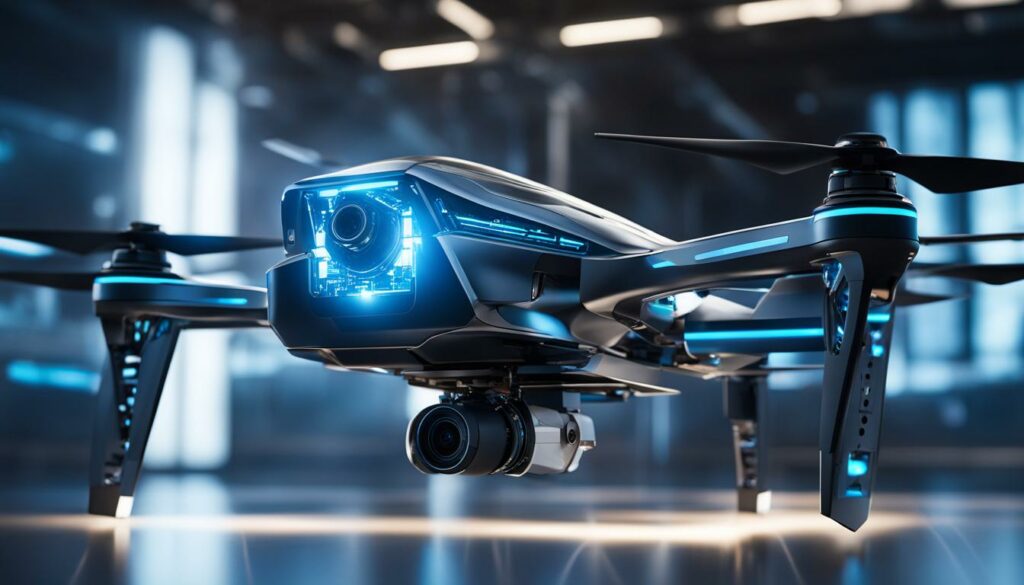
The integration of drones and artificial intelligence is propelling the capabilities of aerial vehicles to new heights. AI-enabled drones are becoming smarter, safer, and more efficient, opening up a world of possibilities across various industries. With navigation planning, machine learning, and advanced data processing, AI-powered drones are transforming the way we work and live. As AI continues to advance, the future of drone technology looks promising, with the potential for further innovation and exciting advancements.
Drones Revolutionizing the Surveillance Industry
One of the most significant advancements in drone technology is its impact on the surveillance industry. Drones have revolutionized the way we monitor and collect data, providing a cost-effective and flexible solution for various surveillance applications.
Drone surveillance allows for aerial monitoring and data collection, providing a unique perspective and overcoming the limitations of traditional surveillance methods. With their advanced cameras and sensors, drones can capture detailed images and videos, enabling security professionals to closely monitor activities and identify potential threats.
Furthermore, drones equipped with thermal imaging cameras can detect heat signatures, making them invaluable for search and rescue operations. In emergency situations, drones can quickly cover large areas and locate individuals in need of assistance. This capability has proven to be crucial in saving lives and expediting rescue efforts.
Benefits of Drone Surveillance:
- Cost-effective: Drones eliminate the need for manual surveillance, reducing labor costs and improving operational efficiency.
- Flexibility: Drones can fly in various environments, providing surveillance capabilities in both urban and rural settings.
- Rapid response time: Drones can be deployed quickly and cover large areas in a short amount of time, enabling swift response to potential threats or emergencies.
- Improved safety: Drones eliminate the need for human presence in potentially dangerous situations, minimizing risks to security personnel.
“Drone surveillance allows for aerial monitoring and data collection, providing a unique perspective and overcoming the limitations of traditional surveillance methods.”
In addition to security applications, drones are also used for inspection purposes. They can be equipped with high-resolution cameras and sensors to assess the condition of infrastructure, such as buildings, bridges, and power lines. This capability significantly reduces the risk associated with manual inspections and enables timely identification of maintenance needs.
The use of drones in the surveillance industry is expected to continue to grow, driven by their versatility and cost-effectiveness. As technology advances, drones will become even more sophisticated, offering enhanced capabilities for monitoring, data collection, and analysis.

| Benefits of Drone Surveillance | Traditional Surveillance Methods |
|---|---|
| Cost-effective | Expensive setup and maintenance costs |
| Flexibility | Limitations in accessing remote or challenging environments |
| Rapid response time | Delayed response due to logistical constraints |
| Improved safety | Potential risks to personnel in hazardous situations |
Examining the Ethical Implications of Drone Technology
As the use of drone technology becomes more widespread, it brings forth a range of ethical concerns that need to be addressed. One of the primary concerns is privacy. Drones equipped with cameras and sensors have the potential to collect sensitive data and invade people’s privacy. This raises questions about the extent to which individuals can expect privacy in public spaces and the need for regulations to protect against unauthorized surveillance.
Another ethical consideration is the use of drones in military operations. While drones offer strategic advantages in terms of reducing casualties and conducting precise strikes, concerns arise regarding civilian casualties and the potential for abuse. The use of drones in targeted killings, for example, has sparked debates about the legality and morality of such actions.
Furthermore, the environmental impact of drones must be taken into account. Although drones offer eco-friendly alternatives for certain tasks, such as aerial inspections and delivery services, they still contribute to carbon emissions and noise pollution. The manufacturing process and disposal of drone components also have implications for environmental sustainability.
The Need for Responsible Drone Use
To address these ethical implications, it is crucial to establish clear regulations and guidelines for the use of drones. Governments and regulatory bodies must work together to strike a balance between the benefits and risks associated with drone technology. Privacy laws need to be updated to reflect the capabilities of modern drones and protect individuals’ privacy rights. Additionally, international agreements should be in place to ensure transparency and accountability in military drone operations.
Companies and individuals operating drones also have a responsibility to use the technology ethically. They should prioritize data protection and implement security measures to prevent unauthorized access to sensitive information. Environmental considerations should be integrated into drone design and manufacturing processes to minimize the carbon footprint and other negative impacts.
By addressing the ethical implications of drone technology proactively, we can harness its potential while minimizing risks. It is essential to strike a balance between innovation and responsible use to build a future where drones positively contribute to society and respect fundamental ethical principles.
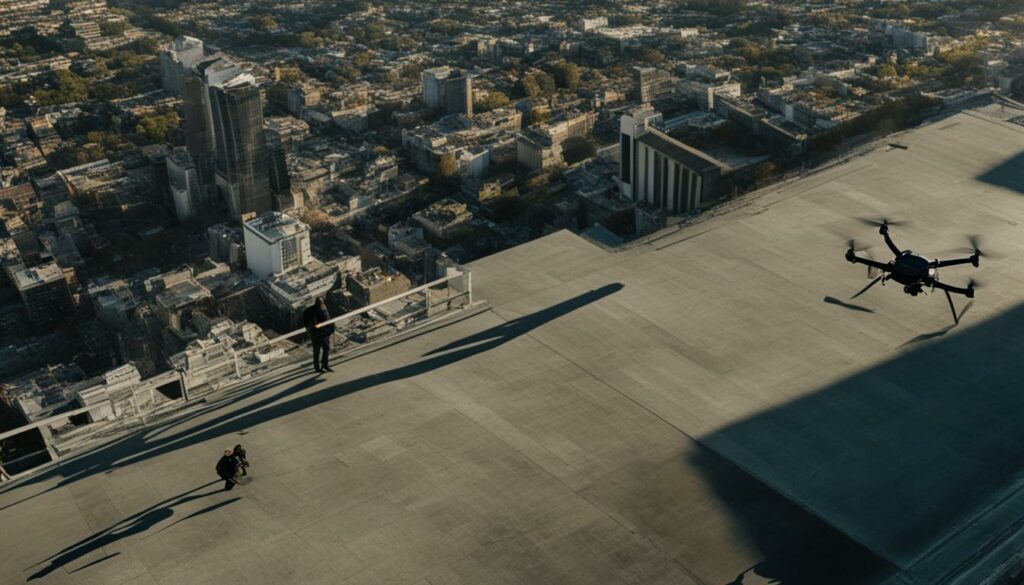
| Ethical Implication | Considerations |
|---|---|
| Privacy | Drones equipped with cameras and sensors raise concerns about unauthorized surveillance and the need for privacy regulations. |
| Military Applications | Debates surrounding civilian casualties and the legality of targeted killings highlight the ethical challenges of drone use in warfare. |
| Environmental Impact | Drones contribute to carbon emissions and noise pollution, necessitating sustainable practices in their manufacturing and use. |
“The use of drones challenges existing ethical frameworks in various domains, including privacy, military operations, and environmental conservation. It is important to establish regulations and guidelines that ensure responsible drone use to address these ethical concerns.” – Drone Ethics Expert
Conclusion
As drone technology continues to advance, the future of aviation is set to be transformed. The drone market is experiencing rapid growth, driven by emerging technologies and increasing industry adoption. With each passing day, drones are becoming smarter, safer, and more powerful, expanding their applications across various sectors.
One of the key factors driving the evolution of drones is the integration of artificial intelligence (AI). AI-enabled drones are capable of navigating, recognizing objects, and performing complex tasks. Companies like DJI and Google are at the forefront of developing AI-powered drones that have the potential to revolutionize industries such as delivery, surveillance, and agriculture.
The impact of AI on drones is set to be significant. The combination of advanced sensors, autonomous capabilities, and AI algorithms will enhance the performance of drones, enabling them to perform complex tasks with precision and efficiency. The potential for autonomous drone delivery, improved surveillance, and data collection is immense, promising increased safety, reduced costs, and enhanced productivity.
Looking ahead, the future of drone technology is full of promise. Continued innovation and advancements in AI, sensor technology, and drone design will pave the way for exciting developments in the field. The drone market will continue to evolve, with new trends and applications emerging. As drones become an integral part of our lives, their positive impact on industries and society as a whole will continue to grow.
FAQ
What industries are embracing drone technology?
The military, commercial, personal, and future technology sectors are leading the way in adopting drone technology.
What are the potential uses of drones?
Drones are used for aerial photography, express shipping, disaster management, search and rescue operations, geographic mapping, building inspections, precision agriculture, unmanned cargo transport, law enforcement surveillance, and storm tracking.
How is the military utilizing drones?
Drones are used for target decoys, combat missions, research and development, and supervision in military operations.
What is the current state of the drone market?
The drone market has witnessed a surge in shipments worldwide, indicating increasing adoption across industries.
What are autonomous drones and their potential applications?
Autonomous drones can transport goods quickly and accurately, revolutionizing the delivery industry. They are also used in precision agriculture and other industries where precise data collection is essential.
How are drones and artificial intelligence intersecting?
AI-enabled drones can navigate, recognize objects, and follow specific targets. They have the potential to revolutionize industries such as agriculture, filmmaking, and public safety.
How are drones disrupting the surveillance industry?
Drones provide a cost-effective and flexible solution for monitoring and collecting data in surveillance, security, inspections, and search and rescue operations.
What are the ethical concerns related to drones?
Ethical concerns include privacy issues, military applications, data collection, and environmental impact, such as pollution and disruption of wildlife.
What is the future of drone technology?
Drone technology is continuously evolving and shaping the future of aviation. The integration of AI, autonomous capabilities, and advanced sensors will revolutionize industries such as delivery, surveillance, agriculture, and more.




